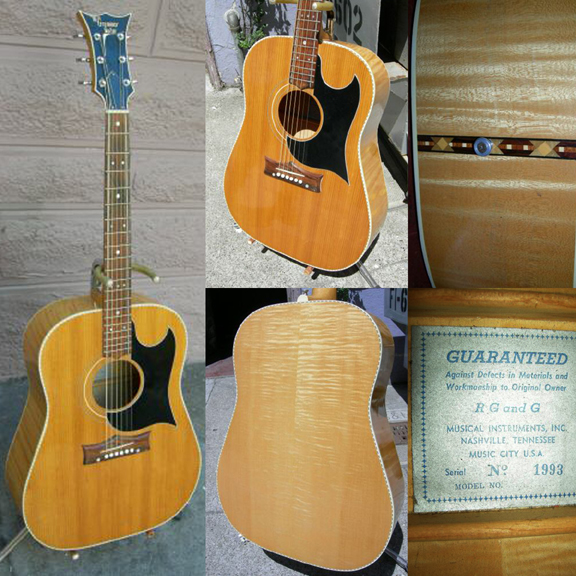
Here are some specifications for the Grammer Guitar
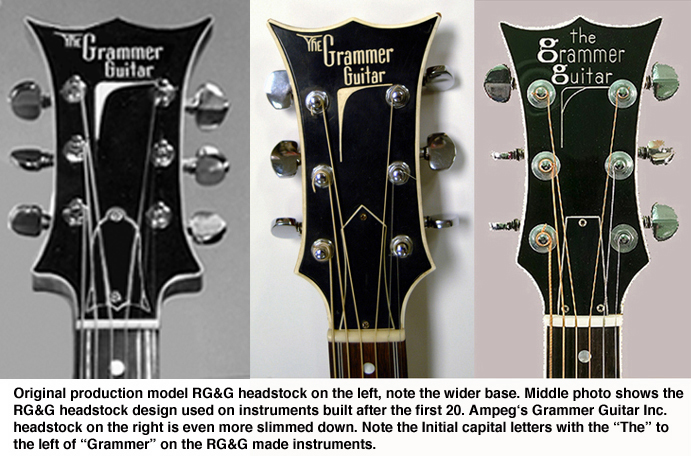
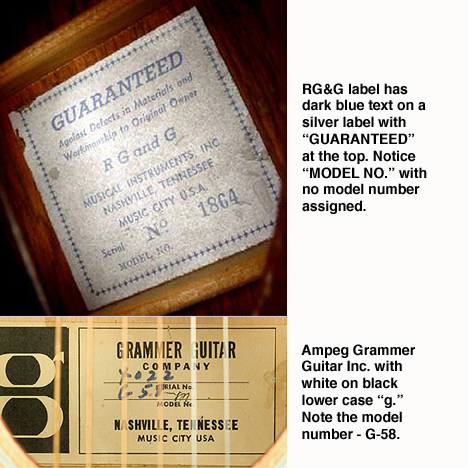
RG&G Specifications and Description taken from the original Grammer Guitar promotional pamphlet:
Description
Guitar Top - Select Sitka Spruce
Back & Sides - Select hard maple. Various color schemes
Neck - Laminated hard maple & adjustable truss rod joined to the body by precision
dovetail
Fingerboard - Finest African ebony, or rosewood, inlaid, our own unique design
Keys - The finest Grover machine heads. Others if quality standards meet our
specifications
Bridge - African ebony or beautiful choice rosewood
Cases - Finest professional leatherette covered, plush lined
Neck Strap Buttons - Already installed on instruments
Lifetime Guarantee - Against defect in materials and workmanship to original
owner
Specifications
Body Width - Upper 12", Lower 15&1/2"
Body Length - 20," Total length of Guitar 40"
Thickness - Butt end 5," Neck end 4"
Neck Scale - 24&1/2 corrected
Neck Sizes - 3 standard: Slim, Medium, & Wide plus custom fitting at the factory
Ampeg Grammer Guitar Inc. Specifications for all models, taken from the Ampeg catalog
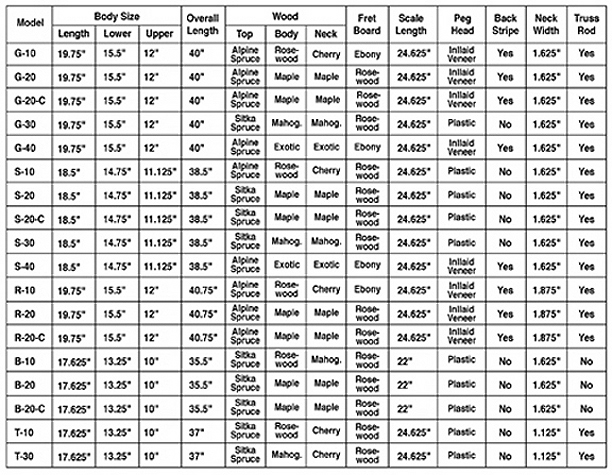
Original RG&G Musical Instruments Inc. flyer for the Grammer guitar
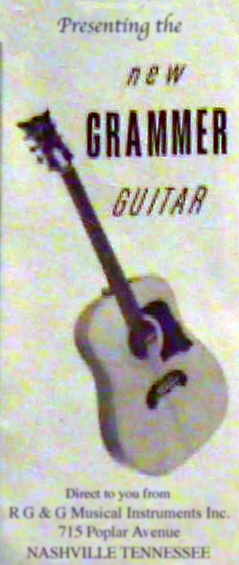
1969 Ampeg Grammer Guitar Inc. Price List
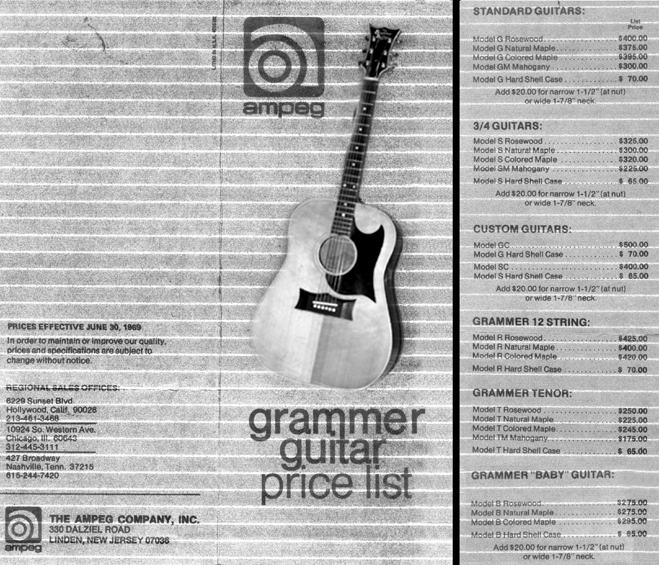

My RG&G Grammer Guitar
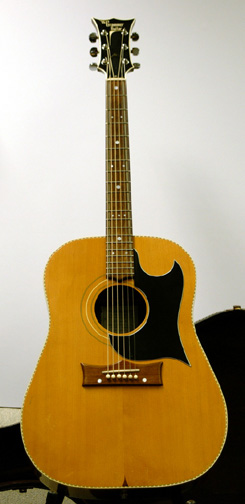
I purchased my Grammer back in 2003. I was hosting the open mic night at a local bar in Virginia and playing my Martin D-41 since it was the only acoustic guitar I had that you could plug into the PA and go. What I didn't know was that people came to the open mic without an instrument and they expected to be able to play my guitar. "No way" I would say! I paid way too much to let some inebriated stranger wack away at my D-41 - the one I had saved for more than a year to get the money for. So I needed another acoustic guitar - one that I wouldn't mind letting others play.
I started looking in the usual places, Larkstreet, Elderly, Gruhn's, GBase, and eBay. I thought about a Takamine, a Guild, something that wouldn't break the bank. I was hoping to spend no more than $1000 - and if I was lucky, maybe a bit less. Then I started drifting back to my childhood and thought about the guitars I loved the most back in the 1960's. The first one that came to mind was a Gibson Hummingbird, or even a Dove. The ones with the fancy pickguards. Of course they were way over my budget. Then I thought about the Grammer and the really great pickguards that they had. I remember going to a traveling Grand Ole Opry show with my Dad in late 60's, and Johnny Dollar was playing a Grammer. It sure was visually striking with the fancy pickguard.
After several months of searching, I decided to look for a guitar made of Brazilian rosewood. I had always read about guitars made with this select wood and how great they sounded and how beautiful they were. The only problem was that most of these were older Martin's and were WAY over my budget. I was looking on eBay and on a whim did a search on Grammer Guitar. To my surprise, one was up for auction from a place called Morgan Music in Lebanon, Missouri. They wanted just under $1000, and this Grammer was made with Brazilian rosewood. Really beautifully veined with several knots here and there. It didn't take long for me to decide to go ahead and make the purchase.
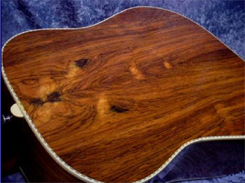
A couple of weeks later, the Grammer arrived. I unpacked it and was happy to see that it was in it's original case. Real nice black faux aligator and in decent shape. The auction advertised the guitar as being a G-58 model and also a players instrument. It wasn't a G-58 I found out later after talking to Billy Grammer, but it was used and had many dings and pings on the spruce top. It had been played quite a bit over it's 35 years. I tuned her up and started playing and my ears perked up when all this rich tone flowed out. It played easily and just sounded so nice and full. Then I turned it over to take a closer look at the Brazilian rosewood. My eyes widened to maximum capacity and my jaw fell. It was much more beauteous than the photos on the computer. Hot Dog! I had a keeper!
If you hold this guitar upside down and look closely at the knots on the back, it looks a bit like a goat. I affectionately call this Grammer the "Billy Goat." I play it all the time now. I still play the Martin, but the Billy Goat goes out on gigs as much as the Martin does. This one has the serial number of 1864 which makes it one of the last ones made at the original factory at 715 Poplar Avenue. This guitar was the inspiration for this web site and has led me back to the creator - aka Billy Grammer. Billy has one of those great minds and remembered the most minute details of those days back in the 60's when he was guitar maker to the stars.
Of course as soon as I had a pickup installed in the Goat, I stopped doing the open mic gigs. And now I am not real keen on letting others play it. But I still have lots of folks approach me and ask me about my beautiful Grammer guitar with the cool pickguard.
Rob Kilgore - Grammer Guitar web curator

Drew Morrison's RG&G Grammer Guitar
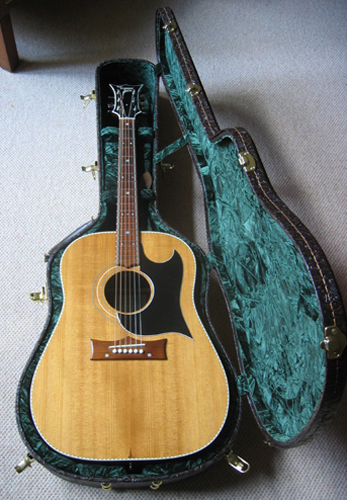
Back in 1980 I received my first guitar book Ken Archard's 'The History and Development of the American Guitar,' I recall at the time being amazed at how many different guitar makers there were out there and of the wide scope in design and finish of their instruments. Of course names like Fender, Gibson and Martin were well known to me but what intrigued me most of all was the lesser known Guitar builders contained in the book, one of which was Grammer. After reading pages 107 and 108 of Mr. Archard's book, it is true to say that I was immediately impressed with the large gothic pickguards and headstocks of the Grammer models shown, even more impressive to me at the time was that big Country stars such as Johnny Cash and Merle Haggard endorsed these Guitars. I thought to myself I would like to own a Grammer one day.
Around 2003 after years of guitar playing and collecting I decided that I needed to find myself a good quality acoustic. Due to my strong aversion of 'having the same guitar everyone else plays,' I needed to find an instrument that was well built with a good tone and yet also more individual in design & look and it was then that I remembered a teenage thought of owning a Grammer guitar. So began my trawl of all the relevant internet sites and local shops for, what became quickly apparent, an elusive Grammer. After sometime I finally found a lovely Grammer guitar which was resplendent with Spruce top and absolutely beautiful Brazilian rosewood back and sides, however, although this guitar was almost perfect I did notice that there was some damage to the binding at the corner of the headstock something which made me briefly stop and think about the purchase and, like so often happens, when I did finally approach the shop owner I discovered that the instrument had only recently been sold. So with some disappointment my quest continued onward.
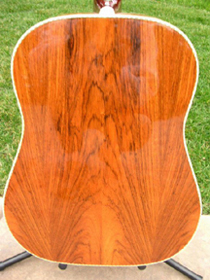
In early 2004 I noticed there was a beautiful Grammer guitar for sale on eBay which looked remarkably similar to the one I had missed out on the year before with the same headstock chip, same woods and so on. Fortunately for me the owner had set the opening auction price too high for the then current market value and consequently no bids were placed on the instrument. Convinced it was the same guitar I thought to myself this could be second time lucky! After mentioning to my wife that I would like the guitar, she then contacted the Seller and inquired about the instrument and after some negotiations on the price, he finally agreed to sell the instrument to her and so I finally got my elusive Grammer.
On the day it arrived I remember opening the case for the first time and being immediately struck by the beauty of it's aged spruce top and beautiful rosewood back and sides and when I struck the simplest of chords, I couldn't believe how nice it sounded. A deep and lovely tone! The neck I found was very easy to play which after some research I found out was a stipulation of Billy Grammer in the early development of the Grammer guitar. After a few days of playing I began to realize that I had just received a truly special guitar. In his auction the previous owner had stated that "If you have ever played, owned or lusted for a fine Martin vintage guitar, you will appreciate the quality, craftsmanship, sound and playability of this Grammer guitar." Well to that all I can say is, I have played many Martins both new and vintage and not one of them has surpassed or made me think of trading in my Grammer guitar. So I guess he was right. But hey, please don't take my word for it, whilst on your travels, if you ever come across an early blue labeled RG&G Grammer guitar, pick it up and strike a simple chord and a have a listen. You may find to your surprise that you don't want to put the darn thing down.
Drew Morrison - Grammer Guitar enthusiast, London, England
Note of Interest - Drew's Grammer has the serial number of 1861, so our guitars were more than likely built during the same week.

Bobbi Geyer's RG&G Grammer Guitar
This is Grammer guitar number 1061, or the 61st Grammer built by RG&G. It certainly is in near mint condition judging by these photographs. The owner is a gal by the name of Bobbi Geyer, who owns and operates Windy Strings in Manassas, Virginia. The story goes that this was originally purchased by a police officer back in 1966. After he passed away, his widow sold it and it was purchased by Dave Schenkman who owns and operates the Turtle Hill Banjo Company in Southern Maryland. Bobbi was doing some work for Dave and took this Grammer guitar as partial payment.
This guitar has the wider based headstock and the mustache bridge. The birds eye maple is beautiful to say the least. One gorgeous Grammer guitar!
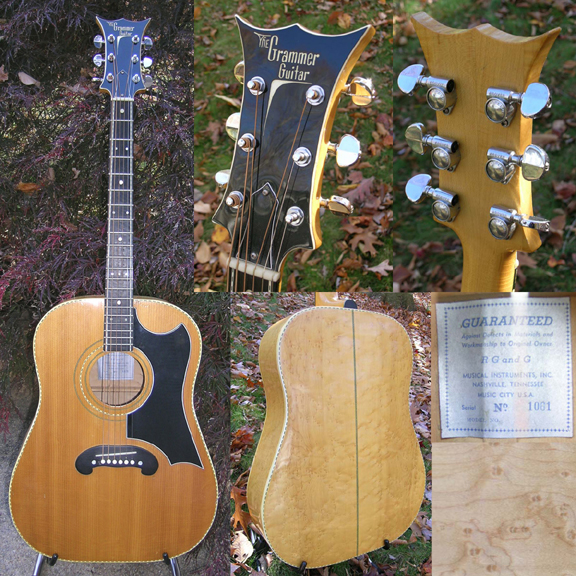

The Last Grammer Guitar made by RG&G?
One of my duties as curator for the Grammer Guitar web site is to constantly check the internet to see what Grammer's are up for sale or auction. Since there are no records left to tell us how many guitars were produced by RG&G, I keep hoping that one will come up with the 2000 number, but so far, no luck. This is Grammer guitar number 1993, or the 993rd Grammer built by RG&G. It has been estimated that RG&G made approximately 1000 guitars - give or take a few. So this could possibly be the last RG&G Grammer to come out of 715 Poplar Avenue back in 1968 before Ampeg/Unimusic took over and the fire destroyed the factory.
This one has flamey maple back and sides with all the Grammer touches. The vertical neck inlay, checkerboard binding, and the beauteous inlay at the bass of the instrument by the end pin.
